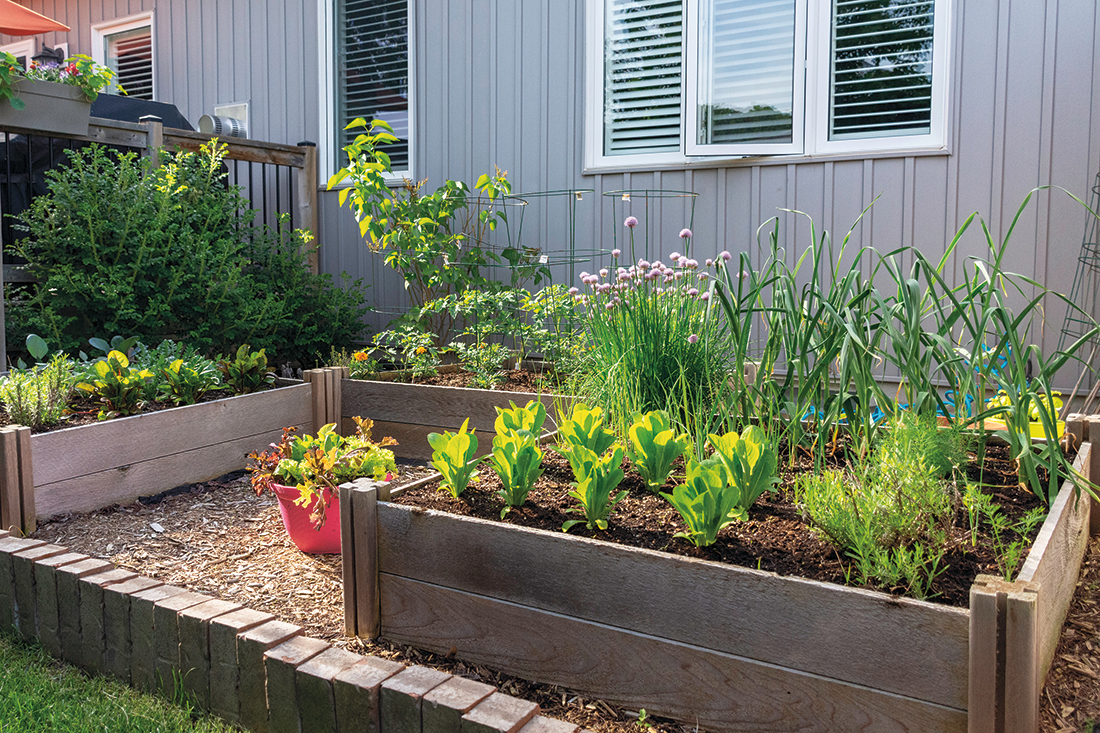
Grow your Own Way
Eating fresh food that’s good for you and the planet is waiting for you on your balcony or in your backyard as Edwina Cattanach discovers!
There really is nothing quite like picking fresh herbs, fruit or veggies straight from your garden and adding to your cooking. Home-grown produce is superb in flavour, nutritional value and the best reward for all the efforts you put into growing your little patch of goodness.
For much of the day, I think with my stomach, in the mornings, I start the day imagining what I’m going to have for breakfast and my internal clock tells me when it is getting close to lunch and dinner. Having fresh herbs and other produce at my fingertips really does influence what I end up cooking. There are many reasons why you should be growing food at home. It would be easy to list all the benefits for the environment; how it’s good for your health, overall wellbeing and mindfulness; how it teaches seasonality, and in turn what to buy from the supermarket. Then of course there is the therapeutic aspect, relaxing outside in the sun and seeing your work paid off by the food supply you have ready at your fingertips.
There are no strict rules when it comes to gardening, just a little planning required when considering the space you have and the time of year for best results. So, if you love food, and want to grow some of your own, here are a few tips on how to go about setting up a veggie patch at home.
Start small
The most economical way to grow your own food is to start digging up your backyard if you have one. If not and space is an issue, or you are renting, then the best options are planter boxes and pots. Even a few pots on the kitchen bench can add freshness to the plate.
The Good Space
Plant crops that give you fresh produce for much of the year and suit your culinary skills. ‘Cut-and-come-again’ growers like lettuce and herbs are some of the best plants to grow when getting started. They are hardy and will consistently provide you with ingredients for delicious meals. Easy to grow and compact plants are tomatoes, eggplant and capsicums. Say no to onions or parsnips as they need lots of space for long periods of time.
Chase the sun
Sunlight is the essence of all life. Access to the sun’s rays is therefore the biggest factor when choosing where to grow your own food. Doonan Valley Garden says that most veggies like six to eight hours of direct sunlight so best to position your veggie patch where it’s going to soak up the maximum sunshine.
Water it!
Too little water and your veggies will wither and die; too much water, and you may end up killing your crop with kindness. The best approach is by hand. Feel the topsoil and gauge the moisture level. It really is that simple. If the soil is damp, hold off on the watering. Time spent watering is one of the great pleasures of growing your own food but avoid watering in the middle of the day – stick to the early morning or late afternoon/early evening when the sun isn’t as intense.
Love your soil
You are growing soil first, plants second. Like the foundations of a house, plants need good soil, or they’ll eventually fall over. Invest in good-quality potting mix if you’re growing in pots and if you’re planting straight in the ground, be sure to feed the soil regularly with organic fertiliser. After all, it’s feeding your plants which will in turn feed you. Top up with compost and manures at the end of a growing season. In winter, liquid fertilisers are preferable, as they allow the plants to absorb nutrients quicker. Liquid fertilisers are easy to make using your own compost tea or weed tea. To make a brew, put a couple of handfuls of compost in a bucket, and let seep for a few days.
Then strain the liquid into a bucket or watering can. Dilute at a ratio of 1:4 with your liquid and water, pour over the leafy green vegetables and soil and watch them grow!
Grow what you love
From fresh mint for tea or cocktails; limes for your afternoon G&T; to basil and tomatoes for a quick, easy and nutritious salad. Love pumpkin soup? Sprinkle a few seeds amongst the base of your trees. Reaping the rewards of your harvest is the best bit.
Maintenance
Check your garden regularly for signs of insect damage or disease and apply some natural home-made remedies. There are plenty of recipes available online or talk to your local garden centre for off the shelf branded products.
Good gardening does involve a bit of research and planning. Understand what can grow in our climate and when you should be sowing seeds, planting seedlings and harvesting or pruning.
The best advice is from your local garden centres. Manawee Garden Centre and Doonan Valley Garden Centre both have helpful and expert staff to guide you with the ‘what, where and when’ for all your planting needs! For bigger projects, call in the experts at Earth Creation Landscapes who can help design and create the perfect plot for your patch.



